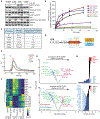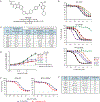Kinase-impaired BTK mutations are susceptible to clinical-stage BTK and IKZF1/3 degrader NX-2127
- PMID: 38301010
- PMCID: PMC11103405
- DOI: 10.1126/science.adi5798
Kinase-impaired BTK mutations are susceptible to clinical-stage BTK and IKZF1/3 degrader NX-2127
Abstract
Increasing use of covalent and noncovalent inhibitors of Bruton's tyrosine kinase (BTK) has elucidated a series of acquired drug-resistant BTK mutations in patients with B cell malignancies. Here we identify inhibitor resistance mutations in BTK with distinct enzymatic activities, including some that impair BTK enzymatic activity while imparting novel protein-protein interactions that sustain B cell receptor (BCR) signaling. Furthermore, we describe a clinical-stage BTK and IKZF1/3 degrader, NX-2127, that can bind and proteasomally degrade each mutant BTK proteoform, resulting in potent blockade of BCR signaling. Treatment of chronic lymphocytic leukemia with NX-2127 achieves >80% degradation of BTK in patients and demonstrates proof-of-concept therapeutic benefit. These data reveal an oncogenic scaffold function of mutant BTK that confers resistance across clinically approved BTK inhibitors but is overcome by BTK degradation in patients.
Figures





Comment in
-
BTK degraders tackle drug resistance.Nat Rev Drug Discov. 2024 Mar;23(3):173. doi: 10.1038/d41573-024-00027-1. Nat Rev Drug Discov. 2024. PMID: 38336888 No abstract available.
References
Publication types
MeSH terms
Substances
Grants and funding
LinkOut - more resources
Full Text Sources
Other Literature Sources

